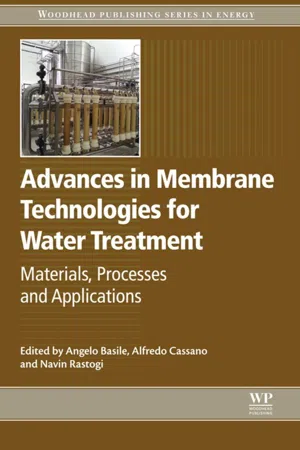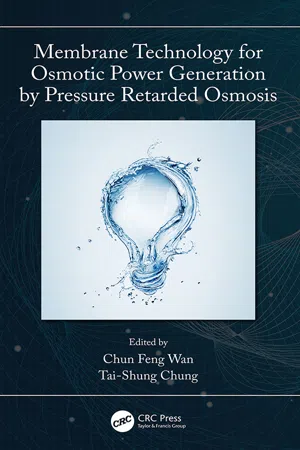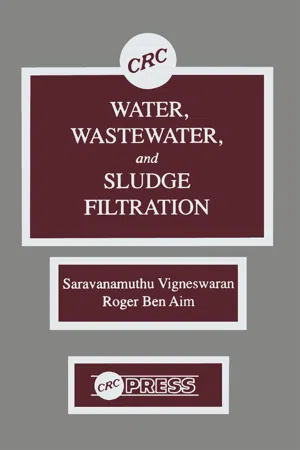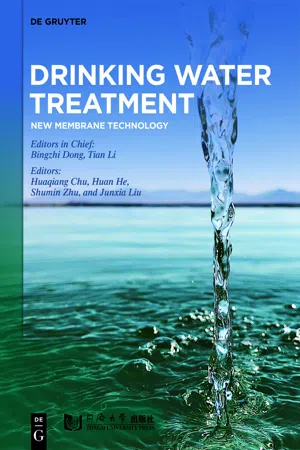Technology & Engineering
Osmotic Pressure
Osmotic pressure is the pressure exerted by the movement of solvent molecules through a semipermeable membrane to equalize the concentration of solute on both sides. It is a key factor in processes like filtration, purification, and desalination, and is used in various engineering applications such as reverse osmosis systems. Understanding osmotic pressure is crucial for designing efficient separation and purification technologies.
Written by Perlego with AI-assistance
Related key terms
6 Key excerpts on "Osmotic Pressure"
- Paul C. Hiemenz, Raj Rajagopalan, Paul C. Hiemenz, Raj Rajagopalan(Authors)
- 2016(Publication Date)
- CRC Press(Publisher)
It is the rate of separation rather than the efficiency of salt retention that is the primary practical issue in the development of reverse osmosis desalination. In addition to a variety of other factors, the rate of reverse osmotic flow depends on the excess pressure across the membrane. Therefore the problem of rapid flow is tied into the technology of developing membranes capable of withstanding high pressures. The Osmotic Pressure of sea water at 25°C is about 25 atm. This means that no reverse osmosis will occur until the applied pressure exceeds this value. This corresponds to a water column about 840-ft high at this temperature.Note that a solution more concentrated than the original one also results from the reverse osmosis process. This means that the method of reverse osmosis may also be used as a method for concentrating solutions. Fruit juices and radioactive wastes, for example, have been concentrated by this method.REVIEW QUESTIONS1. Describe in simple terms what Osmotic Pressure is. Does a solute have to have charges for it to have an Osmotic Pressure?2. What is the relation between the chemical potential of a solute in a solution and its Osmotic Pressure? 3. Is the presence of a semipermeable membrane separating solutions at two different concentrations needed for Osmotic Pressure to exist? 4. Describe some examples of phenomena or processes that are influenced by the Osmotic Pressure.5. Describe an experiment that can be used to measure Osmotic Pressures of colloids or macromolecular solutions. Can the Osmotic Pressure of a colloid or a polymer solution exceed atmospheric pressures? If yes, under what conditions? If not, why?- eBook - ePub
Advances in Membrane Technologies for Water Treatment
Materials, Processes and Applications
- Angelo Basile, Alfredo Cassano, Navin Kumar Rastogi(Authors)
- 2015(Publication Date)
- Woodhead Publishing(Publisher)
http://www.tandfonline.com ).4.4. Fundamentals of water treatment by RO
Osmosis is the basis for RO. When a semipermeable membrane separates a dilute solution from a concentrated solution, the solvent (water) crosses from the dilute solution side to the concentrated solution side of the membrane to equalize concentrations on both sides; this process is known as osmosis. The flow of solvent can be prevented by applying an opposing hydrostatic pressure to the concentrated solution. The magnitude of the pressure required to completely impede the flow of water is defined as the Osmotic Pressure. In the case of RO, a hydrostatic pressure greater than the Osmotic Pressure is applied for water to move from a high-solute to a low-solute concentration (Figure 4.1(b) ). It necessitates high-pressure requirements. The positive difference in pressure creates a chemical potential difference (concentration gradient) across the membrane that drives the liquid through the membrane against the natural direction of osmosis (the movement of water molecules from an area of high concentration to an area of low concentration), while the salts are retained and concentrated on the influent surface of the membrane. Some salt passage through the membrane occurs; salt passage for the same membrane increases with the salt concentration and temperature.The RO process requires high operating pressures ranging from 2300 to 3500 kPa for seawater and 100 to 300 kPa for brackish water to overcome the Osmotic Pressure of feed water (Perry & Green, 1997 ; Sagle & Freeman, 2004 ).The dominant mechanism governing transport through RO membranes can be explained as solution-diffusion, which involves preferential dissolution of solvent (water) in the membrane and its transport through diffusion. Water transport across an RO membrane occurs in three separate steps: absorption onto the membrane surface, diffusion through the thickness of the membrane, and desorption from the permeate surface of the membrane. Once a water molecule has absorbed onto the membrane surface, the water concentration gradient (of the water-membrane system) across the membrane causes the water molecules to diffuse down the concentration gradient to the permeate side of the membrane. The water molecule then desorbs from the membrane and becomes part of the bulk permeate (Lonsdale, Merten, & Riley, 1965 ; Paul, 2004 - Tai-Shung Chung, Chun Feng Wan, Tai-Shung Chung, Chun Feng Wan(Authors)
- 2020(Publication Date)
- CRC Press(Publisher)
3 to desalinate seawater (UNWWAP 2014). There are growing opportunities for the joint development of water and energy technologies that maximize co-benefits and minimize negative trade-offs. A wide range of opportunities exists to coproduce energy and water and to harvest the benefits of synergies. This book aims to explore such opportunity where wastewater streams can be used to generate clean energy, which in turn can be used to compensate the energy consumption of desalination processes.1.2 Osmotic EnergyNature has the greatest mechanism for plants to take up water from soils and transport it across the cell membranes by forward osmosis (FO) (McElrone et al. 2013). In the past decade, FO has received increasing attentions in various water, energy, and food applications. In an FO process, as shown in Figure 1.1 (a) , a semipermeable membrane is placed between two solutions with different salinities – a draw solution with a higher salinity and a feed solution with a lower salinity. Water spontaneously diffuses across the membrane, driven by the chemical potential difference that arises from the salinity difference. The Osmotic Pressure difference (∆π ) between the feed and draw solutions is defined as the hydraulic pressure that has to be applied on the draw solution to stop the spontaneous water flow (Awad et al. 2019, Chung et al. 2012a, 2012b, Shaffer et al. 2015). The term “Osmotic Pressure (π )” implies the potential of a solution to generate power. Osmotic Pressure can be calculated as follows (Van’t Hoff 1901):(1)π = i c R Twhere c is the molar concentration, i is the van’t Hoff factor, R is the universal gas constant, and T- eBook - ePub
- C. Visvanathan, Roger Ben Aim(Authors)
- 2020(Publication Date)
- CRC Press(Publisher)
Figure 1c ).In its simplest form, an RO system consists of the membrane, a structure to support the membrane, a vessel to contain the pressurized solution, and a pump to pressurize the solution (water with dissolved solids). Pump pressure is the exclusive driving force for reverse osmosis (Figure 2 ).1III. MEMBRANES
The heart of the RO process is the membrane. Since Reid and Breton’s discovery in 19542 that cellulose acetate (CA) possesses good ion selectivity, CA has become the most universally studied membrane.1 It was in the early 1960s that Loeb and Sourirajan discovered how to make a cellulose acetate membrane with asymetric density having the specific characteristics required for RO.1When cast as RO membranes, CA is an asymmetric film about 100 µm in thickness. The film has a dense layer of about 0.25 µm above a thick, porous layer (Figure 3 ). Water passes easily from the dense layer to the porous one, but with difficulty the other way around. The dense layer on top of the membrane is made up of tightly packed and organized chains of CA polymer that attract and hold water. Thus, water and solute are separated because the water molecules can form hydrogen bonds with the acetyl groups on the polymer, while other species may not. Thus, CA membranes have the following three essential characteristics, which any RO membrane should have (1) high permeability to water; (2) low permeability to salts; and (3) be easily molded into thin films.The CA membranes, however, have two major limitations, namely: (1) they are susceptible to degradation from biological attack, and (2) CA hydrolyses back to cellulose under acidic and basic conditions. Therefore, the pH of the system must be controlled (usually 4.5 to 7.5) to minimize hydrolysis. The hydrolysis also limits the useful life of the CA membranes, because most salt passes through as hydrolysis occurs. Sometimes diacetates and triacetates of cellulose and mixed esters of cellulose (acetate butyrate or acetate-propionate or acetate benzoate are also used to prepare the membranes. They, too, are very sensitive to hydrolysis. To overcome these shortcomings of CA membranes, in 1970, du Pont commercialized RO devices containing membranes made from an aromatic polyamide (aramid) polymer.1 These membranes are not susceptible to biological attack, resist hydrolysis, and can successfully be used at a wide pH range of 4 to 11. However, because the membranes are degraded by chlorine, water that contains Cl2 - eBook - ePub
The Elements of Qualitative Chemical Analysis, vol. 1, parts 1 and 2.
With Special Consideration of the Application of the Laws of Equilibrium and of the Modern Theories of Solution.
- Julius Stieglitz(Author)
- 2014(Publication Date)
- Perlego(Publisher)
46We find thus that the significant coincidence between the Osmotic Pressure of a substance in dilute solution, as defined and measured according to van 't Hoff, and the gas pressure which the substance would exert, if it were present as a gas in the same volume and at the same temperature, is in agreement with the fundamental assumptions of the kinetic theory. This theory, consequently, gives us an adequate theoretical explanation of [p032] Osmotic Pressure, as it does of gas pressure. As van 't Hoff says,47 "if the Osmotic Pressure follows Gay-Lussac's law and is proportional to the absolute temperature, then, like gas pressure, it will become zero at 0° absolute temperature and will vanish when molecular movements come to rest. It is therefore natural to look for the cause of Osmotic Pressure in kinetic phenomena and not in attractions."48Chapter III Footnotes
[29] L'Hermite, Compt. rend. , 39 , 1177 (1854); van 't Hoff, Lectures on Physical Chemistry , Part II , p. 37 .[30] Nernst, Theoretical Chemistry , p. 103.[31] Van 't Hoff, Lectures on Physical Chemistry, Part II , p. 37.[32] J. Phys. Chem. , 10 , 141 (1906).[33] This term must not be confounded with the term Osmotic Pressure , which has been defined on p. 10 .[34] See Chapter VII on the law of physical or heterogeneous equilibrium, where the relations are discussed in detail.[35] Z. phys. Chem. , 5 , 175 (1890).[36] Ibid. , 3 , 119 (1889).[37] Phil. Mag. , 38 , 206 (1894).[38] Cf. van 't Hoff's Lectures on Physical Chemistry - eBook - ePub
Drinking Water Treatment
New Membrane Technology
- Bingzhi Dong, Tian Li, Huaqiang Chu, Huan He, Shumin Zhu, Junxia Liu, Bingzhi Dong, Tian Li, Huaqiang Chu, Huan He, Shumin Zhu, Junxia Liu(Authors)
- 2021(Publication Date)
- De Gruyter(Publisher)
Chapter 7 Forward Osmosis Membrane Separation TechnologyLin WangSchool of Municipal and Environmental Engineering , Shandong Jianzhu University , Jinan , P. R. ChinaWanzhu ZhangBeijing General Municipal Engineering Design & Research Institute Co., Ltd. , Beijing , P. R. ChinaBingzhi DongCollege of Environmental Science and Engineering , Tongji University , Shanghai , P. R. China7.1 Fundamentals of forward osmosis membrane separation technology
7.1.1 Principles of forward osmosis
Osmosis is a physical phenomenon that has been known to mankindation [1 ]. Forward osmosis (FO) is the spontaneous net movement of water across a selectively semipermeable membrane from a region of higher water chemical potential (i.e. lower Osmotic Pressure) to a region of lower water chemical potential (i.e. higher Osmotic Pressure). The principles of FO and interrelation of FO, reverse osmosis (RO) and pressure-retarded osmosis (PRO) are illustrated in Figure 7.1 [1 ]. As shown in Figure 7.1 , when a semipermeable membrane is used to separate two solutions of different Osmotic Pressures (e.g. salt water and pure water), the water molecules pass through the semipermeable membrane from the side of pure water (feed solution) with low Osmotic Pressure to salt water (draw solution) with high Osmotic Pressure. Due to the additional water molecules, the salt water level continues to rise until the differential of water pressure equals that of Osmotic Pressure across the semipermeable membrane. This process is referred to as FO. PRO can be defined as a process similar to FO, where the hydraulic pressure (ΔP) lower than the Osmotic Pressure difference (Δπ) is applied in the the hypertonic draw solution (DS) side. However, the net water flux is still in the direction of the concentrated draw solution. When RO occurs, where the hydraulic pressure (ΔP) higher than the Osmotic Pressure difference (Δπ) is applied in the DS side, the water molecules reversely move from the hypertonic DS side to the hypotonic feed solution (FS) side. As shown in Figure 7.2 , the relationships of the FO and RO processes are illustrated in the form of coordinate diagram by Lee et al. [2
Index pages curate the most relevant extracts from our library of academic textbooks. They’ve been created using an in-house natural language model (NLM), each adding context and meaning to key research topics.





